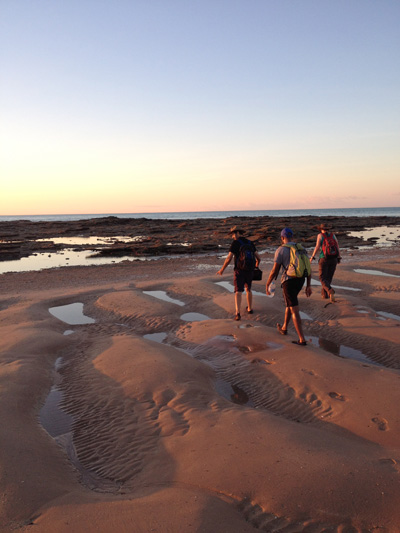We are looking for motivated PhD and Honours students to help research the dinosaur tracks of the Broome Sandstone on the Dampier Peninsula, Western Australia. The Kimberley’s ‘dinosaur coast’ preserves what is arguably one the largest and most significant stretches of dinosaur track-sites in the world. Despite recent National Heritage listing, the majority of these tracksites are largely undocumented, such that their full scientific significance is poorly understood.
As part of a three year ARC Discovery Project (2014–2016), our aim is to digitally map the dinosaur tracksites of the Dampier Peninsula, utilising high-resolution aerial photography with both manned and unmanned aircraft, airborne and hand-held LiDAR imaging, and digital photogrammetry. The results will allow us to construct high-resolution, 3D digital outcrop models of the tracksites, and bring the 130 million-year-old landscapes back to life.
Potential research areas for PhD and Honours projects include the following:
- Detailed analysis and interpretation of new dinosaur tracksites using 3D laser scanning and digital photogrammetry;
- Ichnotaxonomic, behavioural or biomechanical analysis of various types of dinosaur tracks (sauropods, thyreophorans, ornithopods, theropods);
- Palaeoenvironmental analysis and palaeoecology of the Broome Sandstone and its biota (facies analysis, stratigraphy and palaeobiodiversity).
All projects are expected to involve some amount of fieldwork, and funding is set aside to facilitate this. The ARC project will nominally involve three ~10 day field trips each year, with the timing contingent on tides and weather conditions.
Good spoken and written English is desirable. Applicants should ideally have a background in either palaeontology, ichnology, comparative anatomy, biomechanics, sedimentary geology, or digital 3D visualisation.
Please send expressions of interest, along with a CV and academic transcript, to Dr Steve Salisbury.
Good spoken and written English is desirable. Applicants should ideally have a background in either palaeontology, ichnology, comparative anatomy, biomechanics, sedimentary geology, or digital 3D visualisation.
Please send expressions of interest, along with a CV and academic transcript, to Dr Steve Salisbury.
For more background information on the Dinosaur Coast and the recent battle to save it from large-scale industrial development, click here.
ABC Catalyst -- Kimberley Dinosaurs (video + transcript) YouTube
For more information about other potential Honours and PhD projects in the Vertebrate Palaeontology and Biomechanics Lab, click here.
ABC Catalyst -- Kimberley Dinosaurs (video + transcript) YouTube
For more information about other potential Honours and PhD projects in the Vertebrate Palaeontology and Biomechanics Lab, click here.
UQ's Honours program
For more information about Honours in the School of Biological Sciences, click here.
UQ's PhD program
Acceptance into UQ's PhD program is contingent on a meeting the UQ entry requirements. Overseas applications are encouraged, as the School of Biological Sciences has made available a number of competitive international PhD scholarships.
For more information about Honours in the School of Biological Sciences, click here.
UQ's PhD program
Acceptance into UQ's PhD program is contingent on a meeting the UQ entry requirements. Overseas applications are encouraged, as the School of Biological Sciences has made available a number of competitive international PhD scholarships.
- For general information about how to enroll in UQ’s Research Higher Degree program, click here
- For more information on International PhD scholarships in School of Biological Sciences (UQ), click here
- For more information on International PhD scholarships offered at The University of Queensland, click here
- For further information on PhD scholarships for Australian students offered at The University of Queensland, click here






 RSS Feed
RSS Feed
